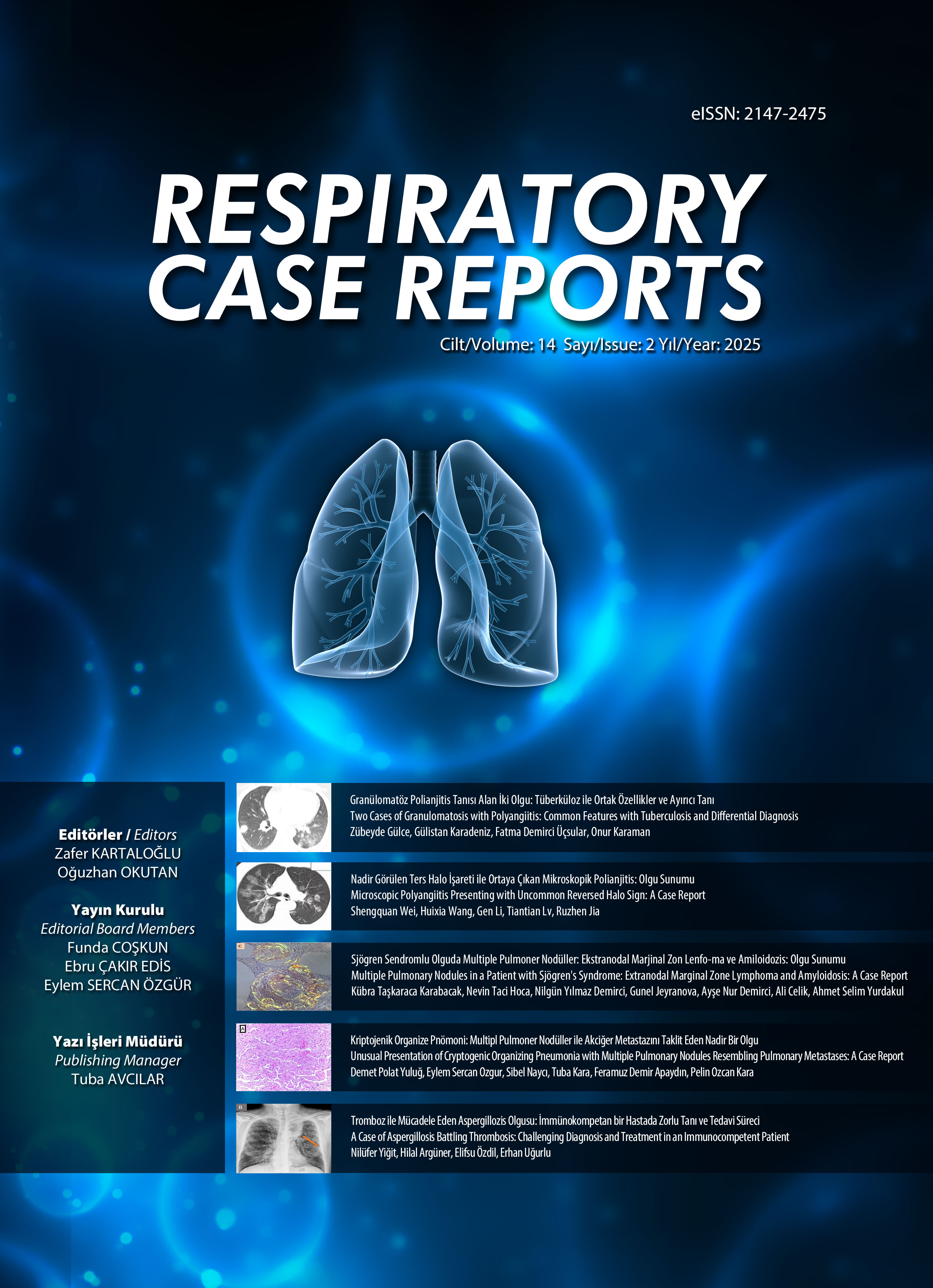e-ISSN 2147-2475

Volume: 9 Issue: 2 - June 2020
| CASE REPORT | |
| 1. | The 2019 Novel Coronavirus Disease (COVID-19) causing Severe ARDS: Serial Computed Tomography Findings Sol Jin, Jin-Young Lee, Jehun Kim doi: 10.5505/respircase.2020.40316 Pages 38 - 42 Since mid-December 2019, a novel coronavirus (COVID-19) has spread to many countries around the world, and the number of critically ill patients with COVID-19 is increasing as the number infections increase. The optimum treatment and prognosis of the disease is still unknown. Here, we present the clinical course and serial computed tomography of a critically ill Korean patient with COVID-19. The progression of COVID-19 infection is fast and aggressive, and no treatment protocol has yet been established. Additional clinical data are required to determine whether or not corticosteroid use is clinically beneficial. |
| 2. | A Life-threatening Complication of Acupuncture Theraphy: Bilateral Pneumothorax Tayfun Kermenli, Cebrail Azar doi: 10.5505/respircase.2020.98360 Pages 43 - 46 One of the potential complications of acupuncture is pneumothorax, caused by the entry of the needle to the visceral pleura and damaging the lung parenchyma. Our patient suffered a bilateral pneumothorax and sudden respiratory failure. Our intention in this study is to offer a reminder of this rare and life threatening complication with this case report. A 51-year-old male patient presented to the emergency department with dyspnea after acupuncture treatment at a hotel spa center. A physical examination revealed no respiratory sound in either lung. A chest X-ray revealed a bilateral pneumothorax. The patient was treated with a bilateral tube thoracostomy. |
| 3. | Phantom Tumor with Real Tumor of The Lung: An Unreported Case Dilek Erdem, İrem Karaman, Adem Dirican, Şevket Özkaya doi: 10.5505/respircase.2020.86570 Pages 47 - 51 A phantom tumor of the lung is a localized collection of transudative interlobar pleural fluid in the settings of decompensated congestive heart failure that resembles a lung neoplasia on chest X-ray, but that vanishes after the appropriate diuretic therapy. Here, we report on a phantom tumor with a real lung neoplasia in the same location, both of which were contributing to the complaints and the clinical picture of the patient. Although phantom tumors are rare and should not be misdiagnosed as masses, it is worth making a further diagnosis and being cautious for possible neoplasia in the same setting. Since the co-existence of heart failure and lung cancer significantly changes the management and follow-up procedure of the patient, a multidisciplinary approach and elaborative work by the pulmonologist, oncologist and cardiologist is required on a case-by-case basis. In such patients, cardiotoxic chemotherapy agents should be avoided as a treatment to prevent the progression of heart failure. The present case confirms the rare possibility of the co-occurrence of lung neoplasia and phantom tumor, and recommends the delicate management of such patients. |
| 4. | Diffuse Large B-cell Lymphoma Exhibiting Endobronchial Involvement: A Case Report İbrahim Güven Çoşğun, Düriye Öztürk, Çiğdem Özdemir, Şule Çilekar, Filiz Yavaşoğlu, Ersin Günay doi: 10.5505/respircase.2020.82435 Pages 52 - 55 Diffuse Large B-cell lymphoma is a subgroup of non-Hodgkin's lymphoma. Lymphoma with endobronchial pulmonary involvement is a rarely reported condition. A 64-year-old male patient was admitted to our clinic with complaints of swellings in the neck and in the bilateral upper limbs, along with shortness of breath. A computed tomography of the thorax revealed diffuse mediastinal enlargement with a superior vena cava obstruction, and a huge right hilar mass formation obliterating the anterior segment of the right upper lobe. A diagnostic fiberoptic bronchoscopy showed mucosal irregularity and an endobronchial lesion on the anterior segment of the right upper lobe. A diagnosis of endobronchial lymphoma was made following bronchial biopsies. |
| 5. | Atypical Carcinoid Tumor Located in the Trachea Emine Afşin, Ayperi Ozturk doi: 10.5505/respircase.2020.68542 Pages 56 - 59 Carcinoid tumors are evaluated in the neuroendocrine tumor group. While they are more common in the gastrointestinal tract, they may rarely be of bronchial origin. They account for 0.51% of all lung cancers, and are usually seen in the young age group. A 78-year-old male patient with a tracheal polypoid lesion was observed at thorax CT. The patient was diagnosed with an atypical carcinoid tumor, and was considered to be inoperable due to his advanced age and severe COPD (FEV1 25%). Due to the extraluminal extension and no metastatic lymph nodes identified radiologically, an Nd: YAG laser was applied and the root of the lesion was cauterized. Complete cure was achieved with an endobronchial treatment approach. |
| 6. | A Case of Massive Pulmonary Thromboembolism in Cardiac Arrest and Tenecteplase Use Yasemin Arı Yılmaz, Meral Gulhan doi: 10.5505/respircase.2020.01328 Pages 60 - 65 Pulmonary thromboembolisms occur mostly in the lower extremity veins. Sudden occlusions of the main pulmonary bed may result in cardiac decompensation. Electrocardiography (ECG) shows right ventricular overload findings, V1-4 T negativity, Q1 pattern in V1, complete or incomplete right bundle branch block and accompanying S1Q3T3. Emergency and rapid treatment can be life-saving. Streptokinase and alteplase administration lasts for hours while tenecteplase administration is in the form of push. This is vital in patients requiring immediate interventions, where minutes can be critical. It also reduces the waiting time of the responsible doctor and loss of labor during the administration of risky drugs, and enables the patient to return to normal in a shorter time. Although there have been many studies in the literature addressing this subject, the available data is insufficient, since there is no indication for use in our country. In the present case, as no alternative drugs were available, tenecteplase had to be used. |
| 7. | Pulmonary Thromboendarterectomy Enabling Renal Transplantation in Patient of Chronic Kidney Disease: A Case Report Halil İbrahim Yakar, Asiye Kanbay doi: 10.5505/respircase.2020.81489 Pages 66 - 69 Pulmonary endarterectomy (PEA) is a surgical treatment approach for the treatment of patients with chronic thromboembolic pulmonary hypertension (CTEPH). The surgery is considered high risk in terms of mortality and morbidity. We present here a patient at high operative risk due to severe pulmonary hypertension (PH) and chronic renal failure (CKD). The 22-year-old male patient was undergoing hemodialysis treatment for three years due to bilateral hydronephrosis-induced CKD, and was admitted to the hospital with increasing dyspnea. The diagnosis of CTEPH was made clinically and radiologically. During the follow-up period, an endarterectomy was planned, although the patient was considered high risk due to insufficient clinical response, despite medical therapy. Bilateral PEA was applied by thoracic surgery team. sPAP decreased from 105 to 35 mmHg on echocardiography, and dyspnea was improved and functional capacity recovered after the PEA surgery. A renal transplantation was contraindicated in the preoperative period due to severe pulmonary arterial hypertension. PEA surgery was enabled to patient kidney transplantation due to an improvement in pulmonary functions and pulmonary artery pressure. We present here a case of CTEPH who had a chance of kidney transplantation after undergoing successful PEA surgery. |
| 8. | Erythema Nodosum Due to Warfarin Treatment in Pulmonary Thromboembolism: A Case Report Derya Yenibertiz, Berna Akıncı Özyürek, Yurdanur Erdoğan doi: 10.5505/respircase.2020.13540 Pages 70 - 73 The most common and important side-effect of warfarin treatment is bleeding. Erythema nodosum, in the form of painful, erythematous nodules in the dermal and subcutaneous tissues, is not a known side-effect of warfarin. In this case, we report on erythema nodosum occurring as a side-effect of warfarin treatment. A 49-year-old female patient was treated for pulmonary thromboembolism after multiple lesions emerged identified as erythema nodosum in a dermatology consultation that were interpreted as a possible side-effect of warfarin treatment. It was concluded that erythema nodosum may present as a side-effect of warfarin. |
| 9. | Nodular Pulmonary Amyloidosis Mimicking Breast Carcinoma Metastasis Ezgi Çimen Çelik, Serkan Yazgan, Soner Gürsoy, Ahmet Ucvet, Zekiye Aydoğdu doi: 10.5505/respircase.2020.46547 Pages 74 - 78 Amyloidosis is a disease that is characterized by an extracellular accumulation of fibril proteins called amyloid in tissues, and organ dysfunction. There are various types of amyloidosis, with nodular pulmonary amyloidosis usually considered a subtype of AL amyloidosis. Surgical excision is usually curative and the prognosis is excellent. This case is presented to emphasize the rare occurrence of pulmonary amyloidosis and the need to keep malignancies in mind in differential diagnosis |
| 10. | Photodermatitis Following the Use of Pirfenidone in a Patient with Idiopathic Pulmonary Fibrosis: an Ultraviolet Recall Reaction Ayse Baccioglu, Ayse Füsun Kalpaklioglu, Tuba Devrim doi: 10.5505/respircase.2020.99267 Pages 79 - 82 Ultraviolet recall is a photodermatitis reaction that can occur in prior ultraviolet burned skin during the administration of systemic medication. No such reaction has been reported with pirfenidone. We report here on a 75-year-male patient who developed acute erosive erythema on his face, forearms and hands under pirfenidone treatment for idiopathic pulmonary fibrosis after 4 months. The initial diagnosis was drug eruption, since it developed after the initiation of pirfenidone, in accordance with hypereosinophilia and solar dermatitis on a skin biopsy, all of which improved with discontinuation. However, the patient tolerated the rechallange test with pirfenidone. The presence of necrotic keratinocytes in a skin biopsy and exaggerated dermatitis was unlikely for photodermatitis, but supported an ultraviolet recall reaction. Pirfenidone was resumed in a tapered dose, and the patient was successfully followed up for 5 months for a relapse of skin reaction, as well as IPF disease activity. This case is important in indicating that the drug can be tolerated with dose adjustment in the presence of an ultraviolet recall reaction in contrast to discontinuation need in drug allergy. |
| 11. | An Extremely Rare Cause of Dyspnea on Exertion: Bronchial Atresia Fatma Tokgoz Akyil, Ahmet Topbas, Mustafa Akyıl doi: 10.5505/respircase.2020.04796 Pages 83 - 86 Congenital bronchial atresia (CBA) is a rare congenital airway malformation that is caused by an interruption to a proximal lobar, the segmental or subsegmental bronchus, hyperinflation and mucoid impaction distal to the atresic bronchus. Patients may be asymptomatic, or a cough, shortness of breath or recurrent infection may be encountered. We present here the case of a 21-year-old male who presented with exertional dyspnea and cough on exertion, and who was diagnosed with congenital bronchial atresia. |
| 12. | Incidental Diagnosis of Partial Anomalous Pulmonary Venous Return: A Case Report Ahmet Emre Hatır, Büşra Özyalvaç, Sevgi Pekcan, Necdet Poyraz doi: 10.5505/respircase.2020.62687 Pages 87 - 90 Partial anomalous pulmonary venous return is a rare congenital cardiac defect characterized by a flow of blood from a few of the pulmonary veins returning to the right atrium rather than the left atrium. Diagnosis of this anomaly can be quite difficult. The condition is usually diagnosed with echocardiography, and magnetic resonance imaging may also be useful. The clinical manifestation and progression of the disease varies depending on the amount of intra-cardiac shunt. Signs or symptoms may include dyspnea, coughing and fatigue. This defect usually causes no negative symptoms and the child can develop normally. This research presents the case on an 8-year-old female patient who complained of coughing and whose abnormal findings on a chest X-ray led to a further investigation. The patient was diagnosed with partial anomalous pulmonary venous return. Diagnosis of this anomaly at an early stage can lead to the patient gaining an awareness of the disease and being able to deal with any complications that arise in the adolescent period. |
| 13. | Negative Pressure Pulmonary Edema and APRV Mode in Invasive Mechanical Ventilation: A Case Report Esra Aktiz Bıçak, Zeki Korhan, Mustafa Bıçak, Osman Uzundere, Cem Kıvılcım Kaçar, Abdulkadir Yektaş doi: 10.5505/respircase.2020.04557 Pages 91 - 95 Negative pressure pulmonary edema is a condition that may develop after an acute obstruction in the upper respiratory tract, or may occur secondary to the elimination of a chronic obstruction. In this case study, we report on the successful management of the APRV mode for severe hypoxia developing after a negative pressure pulmonary edema that developed after an appendectomy. An appendectomy operation was planned by the general surgery clinic for a 33-year-old male patient weighing 85 kg with no known systemic disease history, due to a preliminary diagnosis of acute appendicitis. The patient underwent an appendectomy, after which severe laryngospasm and severe inspiratory effort developed. The patient, who developed a negative pressure pulmonary edema, was treated with the APRV mode and taken to the service on day 5 following the operation. We believe that the use of the APRV mode can dramatically improve hypoxia in cases where hypoxia cannot be corrected in invasive mechanical ventilation. |
| LETTER TO EDITOR | |
| 14. | Non-classic Meigs-Like Syndrome Fatma Tokgoz Akyil, Mustafa Akyıl doi: 10.5505/respircase.2020.78300 Pages 96 - 98 Abstract | |











